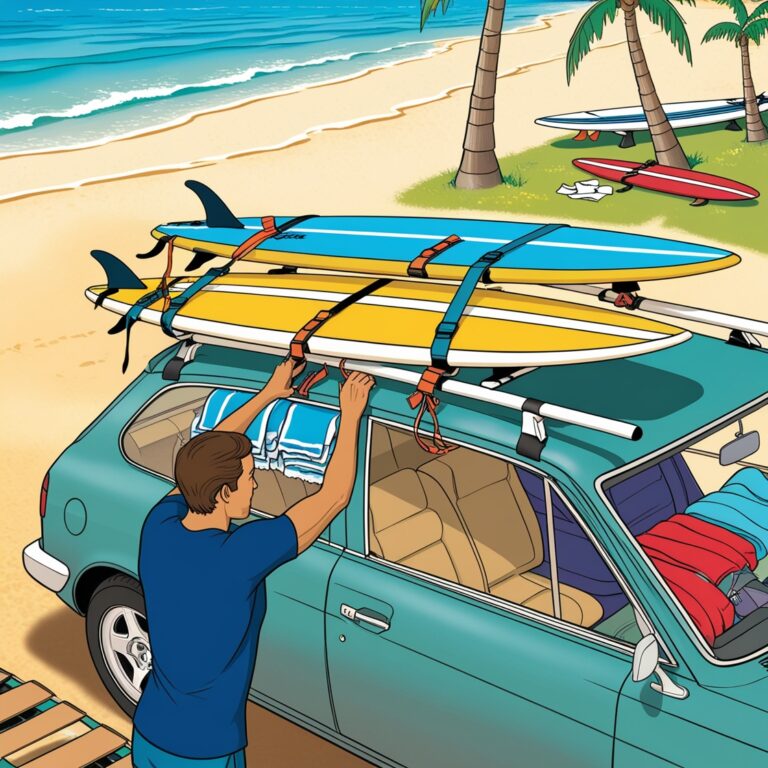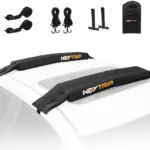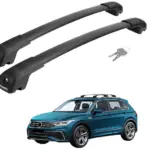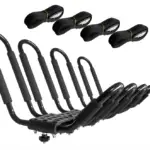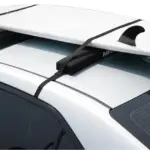If you’re an avid surfer, you know that getting your surfboard from your home to the beach is a crucial part of your surf session. The right roof rack setup ensures that your board arrives in one piece, ready to catch those waves.
However, securely attaching a surfboard to your car roof rack isn’t as straightforward as it might seem. Improperly securing your board can lead to damage, lost equipment, or even accidents on the road.
In this guide, we’ll dive into 17 essential tips for properly securing your surfboard to your car roof rack.
From choosing the right type of rack and using the correct straps to understanding the nuances of board placement, these tips will help you keep your board secure and ready for action. Whether you’re a seasoned surfer or a weekend wave chaser, these insights will ensure that your surfboard remains in prime condition throughout your journey.
Overview: Mastering the Art of Surfboard Transportation
When it comes to transporting your surfboard, precision is key. Ensuring your board is secured correctly on your car’s roof rack isn’t just about avoiding a costly mishap—it’s about guaranteeing that your surfboard arrives in pristine condition, ready for the surf.
-
Choosing the Right Roof Rack System
The foundation of any successful surfboard transport is the roof rack system itself. Opt for a rack that’s designed specifically for carrying surfboards.
- Soft Racks: These are versatile and easy to install, featuring foam pads and straps that cradle the surfboard. They’re ideal for occasional surfers and those without permanent roof rack installations.
- Hard Racks: Made from sturdy materials like aluminum or steel, hard racks offer a more permanent solution. They often come with additional features such as locking mechanisms to enhance security.
-
Preparing Your Surfboard
Before you even think about strapping your surfboard to the rack, a few preparatory steps are crucial. Ensure your board is clean and free of sand or debris. Sand can cause friction and potential damage to both the board and the rack.
-
Using the Right Straps
The most commonly used are cam straps or tie-down straps:
- Cam Straps: Equipped with a cam buckle that tightens securely, cam straps are known for their reliability and ease of use. They’re especially good for holding larger boards in place.
- Tie-Down Straps: These are often used in conjunction with soft racks. They come with various adjustments to cater to different board sizes and shapes.
-
Board Placement
The way you position your surfboard on the rack can make all the difference. Place your board so that the fins are facing upwards, and ensure that the board is centered on the rack.
-
Tightening and Securing
Once your board is in place, it’s time to secure it. Use your straps to fasten the board firmly. Make sure the straps are tightened enough to prevent movement but not so tight that they cause warping or damage to the board.
-
Regular Checks
Before hitting the road, double-check the tightness of your straps and the positioning of your surfboard. During long trips, it’s a good practice to stop periodically and inspect the setup. This ensures that everything remains secure and in place.
-
Additional Tips
- Padding: Use extra padding between the surfboard and the roof rack to prevent scratches and dings. Foam pads or towels can be effective in cushioning the board.
- Locks: If you’re worried about theft, consider using a surfboard lock. These can deter opportunistic thieves and give you peace of mind.
- Weather Considerations: Adjust accordingly or consider alternative transport options if conditions are severe.
Choosing the Best Roof Rack System: A Comparative Guide
When selecting a roof rack system for transporting your surfboard, it’s essential to choose the right one that meets your needs and budget. With various options available, understanding the differences can help you make an informed decision. Below, we’ll compare some of the most popular roof rack systems and highlight where you can purchase them.
Types of Roof Rack Systems
Roof racks come in several varieties, each offering distinct features. Here’s a comparison of the most common types:
| Rack Type | Description | Pros | Cons | Price Range | Where to Buy |
| Soft Racks | Foam pads with adjustable straps | Affordable, easy to install, no permanent installation required | Less secure, may not fit all vehicles | $30 – $80 | Amazon, REI, Walmart |
| Hard Racks | Permanent metal racks with locking mechanisms | Highly secure, durable, built-in features | Higher cost, requires installation | $100 – $300 | Thule, Yakima, Rack Attack |
| J-Bar Racks | J-shaped mounts that hold the board vertically | Space-saving, good for shortboards | May not fit longboards well, requires specific installation | $70 – $150 | Amazon, REI, Sports Authority |
| Surfboard Carriers | Specialized carriers designed specifically for surfboards | Optimal fit for surfboards, additional features like padding | Can be expensive, specific to surfboards | $100 – $250 | Surf Shops, Amazon, Specialty Outdoor Stores |
Factors to Consider
- Vehicle Compatibility: Ensure the roof rack you choose is compatible with your vehicle type and roof design. Some racks are adjustable and fit a variety of vehicles, while others may be specific to certain models.
- Board Size and Type: Choose a rack that accommodates the size and type of surfboard you own. Soft racks are versatile and can fit various board sizes, while hard racks and J-bar racks are better suited for specific board types.
- Ease of Installation: Soft racks generally offer the easiest installation, requiring no tools or permanent fixtures. Hard racks, while more secure, may require professional installation.
- Security Features: If theft is a concern, look for racks with built-in locks or security features.
- Price and Budget: Evaluate your budget and balance it against the features you need. Soft racks are cost-effective for occasional use, while hard racks are a better investment for regular surfers.
Where to Buy
Here’s a list of reliable places where you can purchase roof racks:
- Amazon: Offers a wide range of options with customer reviews to help you make a choice.
- REI: Known for its outdoor gear, REI provides quality racks and knowledgeable staff to assist with your purchase.
- Walmart: Affordable options and convenience with in-store and online shopping.
- Thule: Specializes in high-quality roof racks and accessories with options for various vehicles.
- Yakima: Provides durable and versatile roof racks designed for outdoor enthusiasts.
- Surf Shops: Specialty stores often carry surfboard carriers and offer expert advice.
10 Essential Tips for Securely Attaching Your Surfboard to a Car Roof Rack
Attaching your surfboard to your car’s roof rack might seem straightforward, but there are several nuances to ensure your board stays safe and secure. Here are ten essential tips to help you master the process:
- Choose the Right Rack: Start with a roof rack system that suits your vehicle and surfboard size. Soft racks are versatile and easy to use, while hard racks offer enhanced security and durability. Ensure the rack is compatible with your car’s make and model.
- Inspect the Rack Before Use: Loose parts, rust, or broken components can compromise the security of your surfboard.
- Clean Your Surfboard: Before placing your board on the rack, wipe off any sand, dirt, or debris. This prevents scratching and ensures a secure fit.
- Use High-Quality Straps: Invest in durable straps designed for roof rack use. Cam straps are ideal for their ease of tightening, while tie-down straps can offer additional flexibility.
- Place the Board Correctly: Position your surfboard with the fins facing up.
- Secure with Proper Tension: Tighten the straps firmly but not excessively. Over-tightening can warp or damage your surfboard, while loose straps may cause it to move or fall off.
- Add Padding for Protection: Use foam pads or towels between the surfboard and the roof rack to cushion against impacts and vibrations. This extra layer of padding can prevent damage to both the board and your vehicle.
- Check Alignment and Stability: Before driving off, ensure the surfboard is aligned correctly and stable. Give the straps a final check to make sure they haven’t loosened and adjust as necessary.
- Drive Cautiously: Avoid high speeds and sudden maneuvers. Gentle driving helps keep your surfboard stable and reduces the risk of it becoming dislodged.
- Inspect During Long Trips: On longer journeys, stop periodically to check the surfboard and straps. This ensures everything remains secure and allows you to address any issues promptly.
FAQs: Attaching a Surfboard to Your Car Roof Rack
How do I choose the right roof rack for my surfboard?
Choosing the right roof rack depends on several factors including your vehicle type, surfboard size, and frequency of use. Soft racks are versatile and suitable for occasional use, especially if you don’t have a permanent roof rack. They are easy to install and remove. On the other hand, hard racks offer greater security and durability, making them ideal for frequent surfers. Ensure the rack you select is compatible with your vehicle’s roof and can handle the dimensions and weight of your surfboard.
What’s the best way to secure a surfboard to a soft rack?
To secure a surfboard to a soft rack, start by placing foam pads on the roof of your car to protect both the board and the vehicle. Position the surfboard with the fins facing up and centered on the rack. Use the provided straps or tie-downs to secure the board, ensuring they are tightened firmly but not excessively. It’s crucial to check the straps periodically during transit to ensure they remain tight and the board stays in place.
Can I use a surfboard roof rack with any car model?
Most roof racks are designed to be universal, but compatibility can vary. Soft racks are typically more adaptable and can fit most vehicles, including those without pre-installed roof rails. Consult the rack manufacturer’s guidelines or seek professional advice if you’re unsure.
How tight should I make the straps?
Straps should be tightened securely to prevent the surfboard from shifting, but not so tight that they cause damage to the board. You should be able to press down on the board without much movement but avoid excessive tension that could warp or crack the board. If using cam straps, ensure the cam buckle is engaged properly and adjust as needed.
Is it necessary to use padding between the surfboard and the rack?
Yes, using padding is highly recommended. Foam pads or towels placed between the surfboard and the roof rack help absorb shocks and vibrations, reducing the risk of scratches and dings. This padding also helps distribute pressure more evenly across the board, which is especially important during long trips or rough driving conditions.
How often should I inspect my roof rack setup?
It’s good practice to inspect your roof rack setup before every trip. During longer journeys, stop periodically to ensure the surfboard and straps remain secure. Regular maintenance helps prevent accidents and ensures the longevity of both your surfboard and roof rack.
What should I do if I notice my surfboard shifting during transit?
If you notice your surfboard shifting, pull over safely and check the rack and straps. Adjust the tightness of the straps and reposition the board if necessary. Ensure that the board is centered and that the straps are evenly distributed. Driving cautiously and avoiding sudden maneuvers can also help keep the board stable.
Can I leave the surfboard on the rack overnight?
It’s not advisable to leave your surfboard on the rack overnight, especially in areas prone to theft or extreme weather. If you must leave it on the rack, consider using a surfboard lock and ensure that the area is secure. Additionally, exposure to sun and rain can damage both the board and the rack over time.
Are there specific driving tips to keep the surfboard secure?
Drive at moderate speeds and avoid abrupt turns or stops. High speeds and sudden maneuvers can cause the surfboard to shift or become dislodged. Maintaining a smooth driving style helps keep the board stable and reduces the risk of accidents.
What should I do if I’m unsure about the installation process?
If you’re unsure about installing your roof rack or securing your surfboard, consult the manufacturer’s instructions or seek advice from professionals. Many outdoor or surf shops offer installation services or can provide guidance to ensure your setup is safe and secure.
Conclusion: Master the Surfboard Transport with Confidence
Transporting your surfboard securely is essential for any surf enthusiast aiming to keep their gear in top condition and ready for action. From choosing the right rack—whether a versatile soft rack or a robust hard rack—to using quality straps and proper padding, every detail plays a crucial role in securing your surfboard. Regular inspections and mindful driving further enhance the safety of your setup, helping you avoid unnecessary mishaps.
Remember, the goal is to transport your surfboard with ease and confidence, minimizing the risk of damage and maximizing your time on the water. As you head out on your next surf adventure, keep these tips in mind and ride the waves with peace of mind, knowing that your board is securely in place and ready for the thrill of the ocean. Happy surfing!

